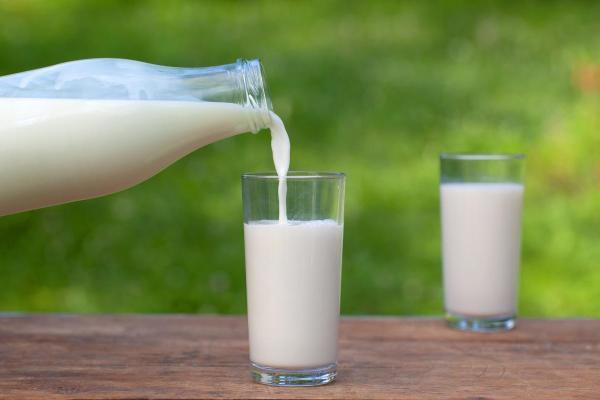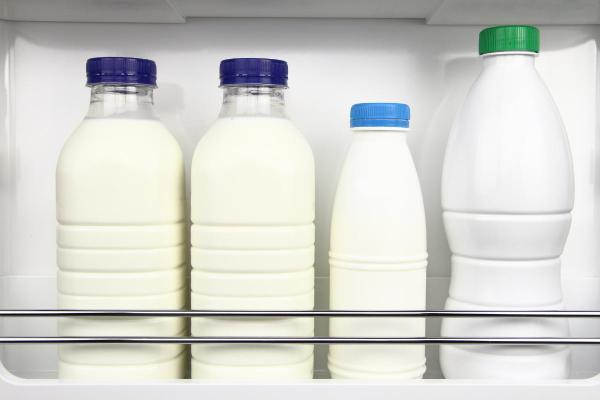
Milk is best drunk fresh if you want the best consistency and flavor. However, milk can be frozen. This is ideal if you want to preserve it for longer. Perhaps you have bought too much milk for an event and you have a gallon left over. You don't want to throw it away, but you won't use it all before it expires. In these cases, you can freeze the milk and defrost it once you need it again. While the nutritional value and basic flavor will remain intact, the milk can change consistency. This is especially so if frozen in large amounts. At thedailyECO, we discover the best way to preserve milk in the freezer with our article asking can you freeze milk to make it last longer?
Can milk be frozen or not?
Milk can be frozen, but doing so can alter its texture. Some find that their defrosted milk can have a slightly grainy texture. This is because the fats are suspended in a solution with other molecules. The freezing process can damage the membrane around the fat drops, such as when ice crystals develop at very low temperatures. This can be exacerbated if you defrost the milk at high temperatures since this can melt the fat and let it escape through the damaged membrane.
Older milk will be more likely to change texture after freezing. This is because the older the milk, the more acidic it will be. This acid can break down proteins which then separate into curds. Since the water content in the milk freezes when temperatures drop sufficiently, freezing can cause the acidity to increase. This can increase the risk of curdling when it defrosts.
Since whole milk has more fat and is, therefore, more acidic, it is more likely to have a grainy texture after freezing. However, you can blend or shake it to help return its consistency.
It is recommended that you use suitable packaging when freezing milk. Use an airtight container or freezer bag, leaving some room for the milk to expand as it freezes. Do not freeze milk in its original packaging, especially if it is glass or thin plastic. It may crack or even explode as it expands.
Thawed milk is most recommended for cooking, smoothies or in preparations where texture is not as critical. Some people find that milk does not taste as good after being frozen, so it may not be the best for drinking. In general, milk can be frozen, but it is more suitable for certain uses after being thawed.
How to freeze milk properly
Freezing milk is a fairly simple process, you just need to follow a few steps to ensure it is preserved in the best way possible:
- Choose the right container: it has to be an airtight container. Use a plastic bottle or a heavy-duty freezer bag. Avoid cardboard or thin plastic containers that can break or leak.
- Leave headroom: milk will expand as it freezes, so leave about an inch (2.5 cm) of headroom at the top of the container to allow for expansion.
- Divide the milk (optional): if you have a lot of milk and don't plan on using it all at once, it's a good idea to divide it into smaller portions. This way, you can defrost only what you need without having to defrost the entire container. Some people may ice cubes out of it so they only take as many cubes as they need out of the freezer.
- Label containers: mark the date on the container so you know how long the milk has been frozen. Frozen milk can be kept in the freezer for about 3 months, although it's best to use it within 1-2 months to ensure freshness.
- Freeze: place the container in the freezer in an area where it won't be crushed or moved. The milk will freeze completely in 2-3 hours, but can be kept frozen for a couple of months.
Discover how to freeze another common home staple with our guide to freezing bread properly.

How long does frozen milk last?
Frozen milk can be kept in the freezer for three to six months without its quality being seriously affected. However, to ensure the best taste and texture, it is recommended to defrost and consume your milk within the first two months after freezing.
Although milk is still safe to consume after six months, its flavor and texture can deteriorate over time. Additionally, it is important to make sure that your freezer is operating at the proper temperature. This should be at least 0ºF (-18ºC). This will help to keep the milk in optimal condition.
When thawing milk, remember that the texture may change as it may become grainier or separate a little. It shouldn't affect the taste or safety, especially if you're using it for cooking or making drinks such as smoothies.
How to defrost milk
The best way to defrost milk is to place the container in the refrigerator for about 12-24 hours, depending on the quantity. Avoid defrosting milk at room temperature. As we have explained, this will help to break down the fat and increase the likelihood of separation. It can also encourage bacterial growth.
After thawing the frozen milk, stir it well. Even if you cannot see it, the milk may have separated during freezing. It may have a slightly grainier or lumpier texture, but this does not affect its nutritional quality or taste. Shaking or blending is even better than stirring.
You can also thaw frozen milk in cold water. If you need to defrost the milk faster, place the airtight container in a bowl of cold water and change the water every 30 minutes to ensure it continues to thaw safely. Don't use hot water as this could affect the quality of the milk and promote bacterial growth.
Although you can freeze milk, you can take a look at our related guide to discover what foods cannot be frozen.

Can you refreeze milk?
Once the milk has been defrosted, you should consume it within 2-3 days. The safety of the milk will depend on the time before expiration date when you freeze it. For example, if you freeze it 10 days before the expiration date, it will be safer for longer than milk frozen the day before the expiration date. This occurs because freezing pauses bacterial growth, but this growth will return once defrosted.
This bacterial growth is the reason why you should not refreeze milk. The bacteria do not die, but become inactive. They will multiply when you defrost the milk, so refreezing means the bacterial load will be greater and will only increase once you defrost it a second time. The same applies for other foods, not only milk.
To learn more about safely preserving food, take a look at our article asking can you freeze raw and cooked mushrooms?
If you want to read similar articles to Can You Freeze Milk to Make It Last Longer?, we recommend you visit our Food & drink category.
- Avoid freezing milk if it has been opened for a long time. It is best to do so when it is still fresh or has just been opened.
- Skim or low-fat milk tends to have a better texture after thawing because it doesn't separate as much as whole milk.
- Do not refreeze thawed milk. Once milk has thawed, do not refreeze it. If you are not going to use it all, it is best to consume it soon or use it in recipes that do not require a perfect texture.
- Barham, P. (2006). To coagulate or not to coagulate...
https://www.theguardian.com/lifeandstyle/2006/feb/17/foodanddrink.features112